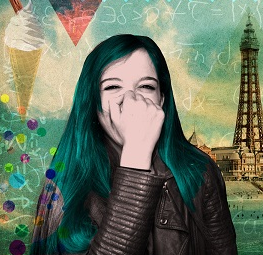Today is an anniversary! I’ve been involved in “The Happiness Project” by the Roundhouse in London for three years today. Anniversaries are a time to celebrate and to reflect on how well things are going.
So here goes.
I was first contacted by a member of the Roundhouse’s performing arts team: they had read my paper “Life Satisfaction and Material Well-being of Young People in the UK” after it was mentioned in the Guardian, and wanted me to feed into a project inspired by the 2007 UNICEF happiness and wellbeing report on young people. They planned to “create a show made by young people for young people”, and did this sound like something that I would be interested in taking part in?
Having experienced mine and others’ life histories being transformed into a sound collage using objects such as coins and matches (!) at a conference earlier that year, the idea of transforming academic text and tables into something artistic that reaches under the skin was not entirely alien to me. I still did not know what to expect. My research analysed which aspects of life are most important for the life satisfaction of children in the UK. It found that family income did not matter for their wellbeing once other aspects of life were taken into account. However, not having access to the things (more) others had, did matter. How could this possibly inform a show by young people?
I was curious and figured I would never know unless I did get involved. But would the university allow me the time and money to get involved in this unpredictable “blue skies” project? Luckily, my research centre has a track record of conducting interviews with young people and getting engaged with young people about the research we do.
I could go for it!
I met with the artistic leadership team at the Roundhouse to brainstorm ideas, and it was so refreshing! I would never have thought that there are so many ways to translate research findings into performing art.
I led a workshop with the young people, talking them through my research, getting them to fill in one of our questionnaires themselves and doing an interactive activity around survey responses on what one thing in life young people would change to make their life better. I had a little bit of stage fright: I am a non-native English speaker and had never before been faced with the challenge of speaking to young people about my research in a format that they would find accessible. I had already learned a lot for my own research; about the ways in which the young people interpret the questions we ask them and how they deal with complex constructs such as quality of life, for example. But the most fascinating thing is to see how the young people have developed as people and performers over the course of three years.
I very much share their excitement at performing at the Roundhouse from 3-14 November 2015. I have not seen the entire show yet but am very much looking forward to it. I will watch the show with a particular focus on where my input has been translated into the show, but from the first snippets I am equally curious to see whether the young people will reach a conclusion on whether “Having” or “Being” is more important for young people’s wellbeing. I hope the play will encourage viewers to think about how they can contribute to increasing their own happiness and that of others.
Read the full blog piece on the ESRC blog page
Read about Gundi’s research in this Observer article
